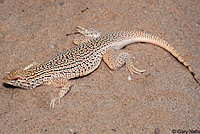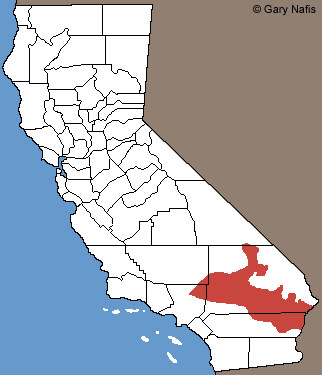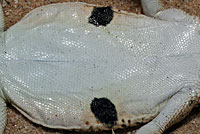California species of Fringe-toed Lizards - Uma

Similar Species:

| Fringe-toed lizards inhabit the southern deserts in areas with fine wind-blown sand, especially sand dunes. They are usually seen basking on dunes in the morning, running quickly over sand into a bush, or diving into loose sand and disappearing. There are three species of Fringe-toed lizards in California, with no overlap in their ranges. Check the range maps to determine which species is found in your area. |
||
 |
||
| Fringes on the toes help these lizards run quickly over areas of fine sand. |
||
| Colorado Desert Fringe-toed Lizard - Uma notata |
||
Found in sandy areas in the Colorado Desert. |
||
 |
 |
 |
| Red: Distribution of Colorado Desert Fringe-toed Lizard in California |
||
| Mohave Fringe-toed Lizard - Uma scoparia |
||
Found in sandy areas in the Mohave Desert. |
||
 |
 |
 |
| Red: Distribution of Mohave Fringe-toed Lizard in California |
||
| Coachella Fringe-toed Lizard - Uma inornata |
||
Found in sandy areas in the Coachella Valley. |
||
 |
 |
 |
| Red: Distribution of Coachella Fringe-toed Lizard | ||
| Comparisons of some physical features of Uma found in California | ||
Coachella Fringe-toed Lizard - Uma inornata |
Colorado Desert Fringe-toed Lizard - Uma notata |
Mohave Fringe-toed Lizard - Uma scoparia |
 |
 |
 |
| Black blotches on the back merge to form broken lengthwise lines | Black blotches on the back merge to form broken lengthwise lines | Black blotches on the back do not merge - there are no broken lengthwise lines |
 |
 |
 |
| Pale streaks on the throat are faded or absent at mid-throat | Dark diagonal lines on the throat | Dark lines on the lower throat form crescent-shaped markings |
 |
 |
 |
| Underside is pale and unmarked. (Fewer than 5 percent of lizards have a small dot or group of dots on the sides) |
Underside has permanent orange or pinkish stripes on the sides | Underside has a black mark on the lower sides |
Return to the Top
© 2000 -
